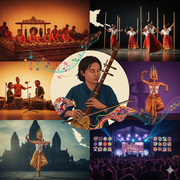How Music Shapes Cultural Identity in Southeast Asia
In music, cultural identity is very strong. Music has been a source of bonding within and between generations, communities and even nations in Southeast Asia. Southeast Asian music continues to shape the perception and expression of culture by the people.
The Traditional Music Cultural Foundation
The Southeast Asian countries possess various soundscapes, which are characteristic of their culture.
Indonesia
 A place where gamelan organizations, whose rhythms are complex and necessary to social activities and rituals, come together.
A place where gamelan organizations, whose rhythms are complex and necessary to social activities and rituals, come together.
Thailand
It comprises of traditional piphat music played in religious and royal events.
Philippines
It secures native instruments, including kulintang that continue to play a key role in the expression of local identity.
Music as a Telling and Preservation Tool
In most of the Southeast Asia countries, music is a significant part of oral traditions. Folk songs and chants are often used to pass myths, historical stories and even lessons.
- Vietnamese ca tru, as an example, keeps the culture stories in the form of poetry lyrics.
- The Myanmar harp music is traditional and relates the story of warriors and kings.
The Modernity and Tradition Completer
Global influences have transformed the southeast Asian music, but they have not forgotten the roots of it. Contemporary artists in the region mix contemporary cultures, such as pop, rock and hip-hop with traditional elements.
- To illustrate, Malaysian fusion artists incorporate electronic music with gamelans.
- Filipino bands use native rhythms in alternative rock.
- Thai pop icons incorporate folk melody in their success in the modern day.
End Notes
Music has a strong connection with cultural identity in Southeast Asia, and serves both as a medium of creativity and a traditional guardian. The rhythm of Southeast Asian music is a reminder that music still lives on for us to feel and listen to.